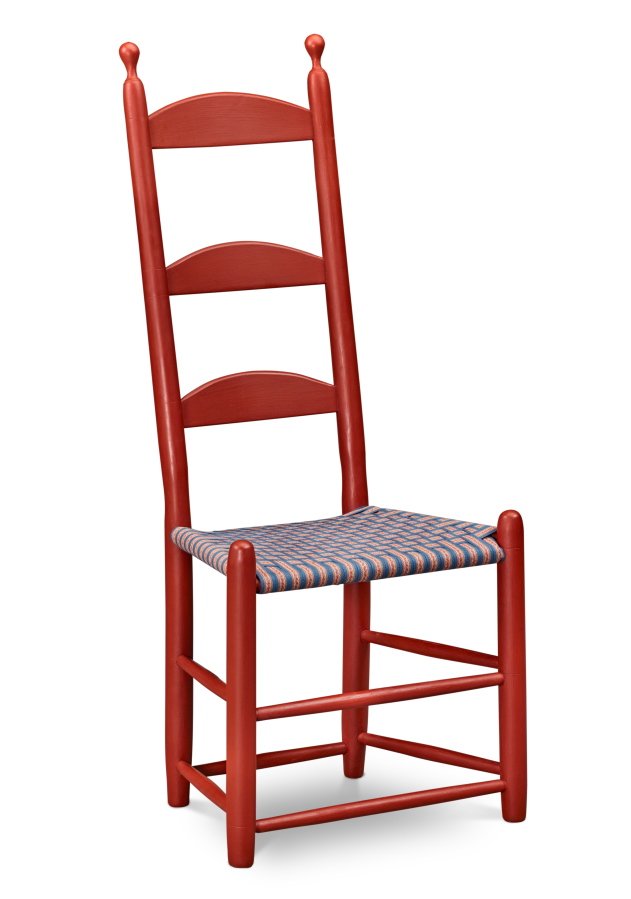NEW YORK — The Shakers, an industrious and pious New England sect that rose to prominence in the 19th century but whose membership has now dwindled from thousands to three, have long had an outsize influence on design and designers.
A new installation at the Metropolitan Museum of Art, “Simple Gifts: Shaker at the Met,” explores Shaker furniture and textiles and their impact. The installation remains on view through June 25.
The Shakers arrived from England in 1774 and saw industriousness as a way of praising God. They embraced communal property, communal living, and racial and gender equality, all radical concepts at the time.
Their furniture, while streamlined and functional, also conveys a modern sensibility.
“They worked very hard to design their furniture according to the golden mean of proportion, and features like graduated drawers were designed using complex calculations,” said Michael Graham, director of the SabbathDay Lake Shaker Museum in Gloucester, Maine, site of the only remaining Shaker community. “It had clean lines, but was not at all simple.”
Unlike some religious sects, the Shakers were far from insular. They were brilliant at marketing, selling their goods through catalogs and in resort communities along the East Coast, said Alyce Perry Englund, assistant curator of American Decorative Arts at the Met, who curated the installation.
Their pragmatism and quest for efficiency led them to use lathes to produce turned chair spindles, and in some cases they made clothing using ready-made fabrics, she said. They borrowed ideas they found useful, such as a revolving chair from 1851 that was a precursor to modern ergonomic office chairs.
The Shakers added tilting discs to chairs’ back legs to make them easier to lean back in; put wheels on beds to facilitate cleaning under them; and commonly used a series of pegs set in rails high on a wall to hang chairs and keep them out of the way when they weren’t in use.
They designed one of the earliest known wrinkle-free waterproof fabrics, and came up with paper envelopes as a way to sell seeds in small quantities, Graham said.
Their cupboards, while void of inlays and other popular adornments of their time, were not rustic so much as intentionally organized, with an eye to geometric lines over fussy distractions, Englund said. The focus was on expert joinery and high-quality streamlined pieces.
The first gallery of the Met’s installation focuses on Shaker furniture design and includes rocking chairs, a revolving chair and a cupboard from the 1800s.
The second gallery focuses on textiles, including a rug, bonnet and dress, alongside furniture and boxes. The big surprise here is the bright colors. Although the popular image of Shaker furniture is of natural finishes, some Shaker chests and boxes of the 19th century come in red, blue and yellow washes. An oval rug dazzles in bright hues, and an otherwise unadorned bonnet features a thin strip of sky-blue piping in the back.
The third and final gallery features a projection of “Appalachian Spring,” a televised 1958 performance showing Martha Graham dancing to Aaron Copland’s score, amid props by Modernist designer Isamu Noguchi. It is one of many intersections between Modernism and Shaker aesthetics.
“The Shakers began selling their century-old furniture to buy more modern furniture for themselves, and to earn money for their community, just as the Modernists were searching for inspiration in their quest for spare and functional design,” Michael Graham said.
Danish Modern furniture, in particular, was heavily inspired by Shaker aesthetics, Englund and Graham said. Both Shaker and Modernist furniture were first exhibited by major museums in New York in the 1930s, gaining broader popularity.
The Met’s show ends with a video by contemporary sculptor Tom Sachs, famous for assemblages of computers and other technology, who explains the deep connection he feels with Shaker ideals.
“These were people who, through the narrow focus of their beliefs, invented incredible things like little tilters on the backs of the chairs. The idea of even leaning back in a chair seems so decadent or indulgent,” Sachs says in the video.



